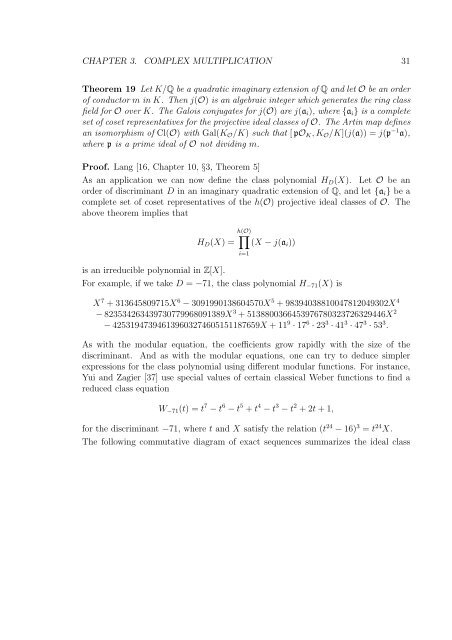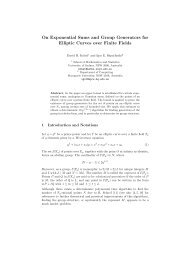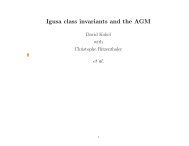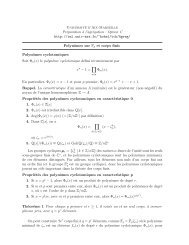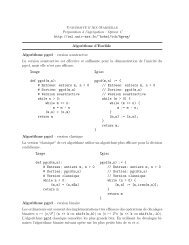Endomorphism rings of elliptic curves over finite fields by David Kohel
Endomorphism rings of elliptic curves over finite fields by David Kohel
Endomorphism rings of elliptic curves over finite fields by David Kohel
You also want an ePaper? Increase the reach of your titles
YUMPU automatically turns print PDFs into web optimized ePapers that Google loves.
CHAPTER 3. COMPLEX MULTIPLICATION 31Theorem 19 Let K/Q be a quadratic imaginary extension <strong>of</strong> Q and let O be an order<strong>of</strong> conductor m in K. Then j(O) is an algebraic integer which generates the ring classfield for O <strong>over</strong> K. The Galois conjugates for j(O) are j(a i ), where {a i } is a completeset <strong>of</strong> coset representatives for the projective ideal classes <strong>of</strong> O. The Artin map definesan isomorphism <strong>of</strong> Cl(O) with Gal(K O /K) such that [ pO K , K O /K](j(a)) = j(p −1 a),where p is a prime ideal <strong>of</strong> O not dividing m.Pro<strong>of</strong>. Lang [16, Chapter 10, §3, Theorem 5]As an application we can now define the class polynomial H D (X). Let O be anorder <strong>of</strong> discriminant D in an imaginary quadratic extension <strong>of</strong> Q, and let {a i } be acomplete set <strong>of</strong> coset representatives <strong>of</strong> the h(O) projective ideal classes <strong>of</strong> O. Theabove theorem implies thatis an irreducible polynomial in Z[X].h(O)∏H D (X) = (X − j(a i ))For example, if we take D = −71, the class polynomial H −71 (X) isi=1X 7 + 313645809715X 6 − 3091990138604570X 5 + 98394038810047812049302X 4− 823534263439730779968091389X 3 + 5138800366453976780323726329446X 2− 425319473946139603274605151187659X + 11 9 · 17 6 · 23 3 · 41 3 · 47 3 · 53 3 .As with the modular equation, the coefficients grow rapidly with the size <strong>of</strong> thediscriminant. And as with the modular equations, one can try to deduce simplerexpressions for the class polynomial using different modular functions. For instance,Yui and Zagier [37] use special values <strong>of</strong> certain classical Weber functions to find areduced class equationW −71 (t) = t 7 − t 6 − t 5 + t 4 − t 3 − t 2 + 2t + 1,for the discriminant −71, where t and X satisfy the relation (t 24 − 16) 3 = t 24 X.The following commutative diagram <strong>of</strong> exact sequences summarizes the ideal class


